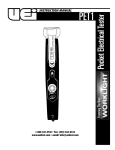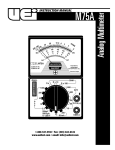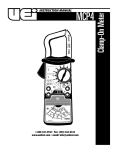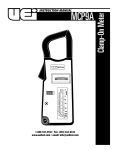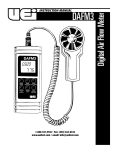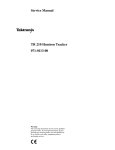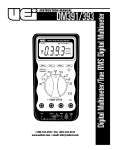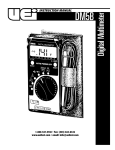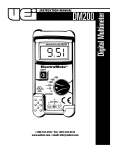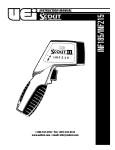Download INSTRUCTION MANUAL - Calright Instruments
Transcript
INSTRUCTION MANUAL M110A 1-800-547-5740 • Fax: (503) 643-6322 www.ueitest.com • email: [email protected] Introduction The M110A, in addition to high-resolution voltage and ohms scales needed for electrical troubleshooting also includes the features that help you maintain and troubleshoot HVAC/R systems. Features like DC millivolts and microamps let you troubleshoot flame safeguard circuits and the millivolts function helps you evaluate heat anticipators. Features include • 21 ranges • 600 Volts AC and 300 Volts DC • 2 Megohm resistance • High resolution DC µA for flame safeguard testing • DC millivolt scale allows use of adapters • Color-coded and mirrored scale plate Safety Notes Before using this meter, read all safety information carefully. In this manual the word "WARNING" is used to indicate conditions or actions that may pose physical hazards to the user. The word "CAUTION" is used to indicate conditions or actions that may damage this instrument. • Always follow industry standard safety practices including protective clothing, gloves and safety glasses when appropriate • Do not attempt to measure any voltage that exceeds the ca t e g o rybased rating of this meter • Do not attempt to use this meter if either the meter or the test leads have been damaged. Turn it in for repair at a qualified repair facility • Ensure meter leads are fully seated by making a quick continuity check of the leads prior to making voltage measurements • Keep your fingers away from the test lead’s metal probe contacts when making measurements. Always grip the leads behind the finger guards molded into the probes • Use a current clamp adapter when measuring current that may exceed 10 amps. See the accessories in UEi’s full-line catalog • Do not open the meter to replace batteries or fuses while the probes are connected WARNING! Exceeding the specified limits of this meter is dangerous and can expose the user to serious or possibly fatal injury. • Voltages above 60 volts DC or 25 volts AC may constitute a serious shock hazard • Always turn off power to a circuit (or assembly) under test before cutting, unsoldering, or breaking the current path Even small amounts of current can be dangerous • Always disconnect the live test lead before disconnecting the common test lead from a circuit • In the event of electrical shock, ALWAYS bring the victim to the emergency room for evaluation, regardless of the victim’s apparent recovery - Electrical shock can cause an unstable heart rhythm that may need medical attention M110A-MAN • Higher voltages and currents require greater awareness of physical safety hazards - Before connecting the test leads; turn off power to the circuit under test; set the meter to the desired function and range; connect the test leads to the meter first, then to the circuit under test. Reapply power • If any of the following indications occur during testing, turn off the power source to the circuit under test: • Arcing • Flame • Smoke • Extreme Heat • Smell of Burning Materials • Discoloration or Melting of Components CAUTION! Do not attempt to re m ove the meter leads from the circuit under test. The leads, the meter, or the circuit under test may have degraded to the point that they no longer provide protection from the voltage and c u r rent applied. If any of these erroneous re a d i n gs are observed, disconnect power immediately and recheck all settings and connections. Controls and Indicators 1. Selector Switch: Is used to select the circuit function and range. It is good practice to start with the highest range setting of the “SELECTOR” switch for a particular function if the magnitude of the function is unknown. 2. Ω ADJ: The “Ω ADJ” control is used on the OHMS function. The purpose of this control is to calibrate the M110A on the particular range selected (Rx1, Rx10, etc.) 3. Mechanical Zero Adjust: Is a plastic screw located on the meter face just beneath the “LOCK” switch. This adjustment is used to set the pointer to the zero index mark at the left side of the scale plate. 4. Input Jacks: COM (-): The black test lead is used to connect this jack to the negative, or common, side of the circuit test. VΩM (+): The red test lead is used to connect this jack to the positive side of the circuit test. DC 12 0 0 V: This jack is used for the 0 - 1200 V DC (0 - 12 K V DC with optional probe) range of the M110A. The red (positive) test lead is connected to this jack. 3 2 4 1 P. 1 Operating Instructions Color Coding The meter scale plating and front panel are color coded. The DC Voltage and DC Current meter scale and SELECTOR switch positions are in BLACK. The OHMS meter scale and SELECTOR switch positions are in GREEN. The AC Voltage meter scales and SELECTOR switch positions are in RED. To provide an uncrowded easy-to-read meter scale plate a single meter s cale may be used for more than one position of the SELECTOR switch. For example, the meter scale numerals 0 - 30 are used for the follow i n g positions of the SEL E C TO R switch: 300 V DC, 3 V DC, 300 mV DC, 0.03 mA DC and 300 V AC. If the SELECTOR switch range is 300, divide the sca l e numerals by ten. Measuring DC Voltage Set the SELECTOR switch to the appropriate range. Always start with the 300 V DC position if unsure of the magnitude of voltage present. Connect the black test lead to the “COM” jack and to the negative side of the circuit under test. Connect the red test lead to the “+VΩM” jack and to the positive side of the circuit under test. Read the voltage on the black meter scale corresponding to the SELECTOR switch setting. When measuring DC voltage on the 1200 V DC range set the SELECTOR switch to the 300 V Dc position and connect the red test lead to the 1200 V DC jack. The black test lead is connected as before. Measuring DC Current Set the SELECTOR switch to the appropriate range. Always start with the 600 mA DC position if unsure of the magnitude of current present. (Note: 0.03 mA DC = 30 µA DC and 0.06 mA DC = 60 µA). When taking current measurements the meter must be connected in SERIES with the circuit, or circuit element, under test. Break the connection at the point at which current is to be measured. Place the M110A in series with the circuit by connecting the black test lead to the “COM” jack and to the lower voltage side of the circuit. Connect the red test lead to the “+VΩM” jack and to the higher voltage side of the circuit. Read the current on the black meter scale corresponding to the SELECTOR switch setting. Set the SELECTOR switch to the appropriate range. Connect one test lead to the “COM” jack and the other test lead to the “ +VΩM” jack. Touch the free ends of the test leads together. The pointer will swing to the right hand side of the scale. Adjust the “Ω A D J” control until the pointer is set on the green numeral 0. (Note: If this adjustment cannot be made refer to the MAINTENANCE section). Rezero the M110A each time the OHMS setting of the SELECTOR switch is changed. To make the resistance measurement, connect the free ends of the test leads across the element to be measured. The measured resistance value will be the green numeral indicated on the OHMS scale times the multiplier on the SELECTOR switch. For example, if the pointer is on the numeral 4, and the SELECTOR switch is set on Rx10, the resistance is 40 ohms (4 Ω x 10 = 40 Ω). Continuity tests are normally made to test a wire, or element, to see if it is unbroken. Because continuity tests involve low values of resistance, the SELECTOR switch should be set on the Rx1 position. Testing Diodes / Transistors A simple check of diode or transistor quality may be made with the M110A. Using the same test procedure as for measuring resistance, connect one test lead to one end of the diode and the other test lead to the other end of the diode. Note the resistance reading. Then reverse the test leads and again note the reading. If the two readings differ by a factor of ten then the diode, (or transistor junction) is probably good. If the readings are approximately the same then the diode is shorted. If a reading cannot be obtained in either direction, the diode is probably between the base and emitter leads, or between the base and collector leads. Measuring AC Voltage Set the SELECTOR switch to the appropriate range. Always start with the 600 V AC position if unsure of the magnitude of voltage present. Connect the test leads to the “COM” jack and the “+VΩM” jack and to the circuit under test. Read the voltage on the red meter scale corresponding to the SEL E C TOR switch setting. Use the lower red scale marked 6 V ONLY when the SELECTOR switch is set on 6 V AC. For all other V AC measurements use the upper red scale marked 30 V UP. Measuring Resistance Maintenance WARNING! Remove all power to the circuit under test when making resistance measurements. If any voltage is present in the test circuit an erroneous reading will result ad the 6/10A fuse may open. NOTE: When the M110A is set on the Rx1 OHM range, the accuracy of the measurements can be degraded if there is dirt on the probe tips. If the measurements are questionable, clean the tips and input connections of the probes and the input jacks of the M110A. M110A-MAN Periodic Service WARNING! Repair and service of this instrument is to be performed by qualified personnel only. Improper repair or service could result in physical degradation of the meter. This could alter the protection from electrical shock and personal injury this meter provides to the operator. Perform only those maintenance tasks that you are qualified to do. P. 2 These guidelines will help you attain long and reliable service from your meter: • Calibrate your meter annually to ensure it meets original performance specifications • Keep your meter dry. If it gets wet, wipe dry immediately. Liquids can degrade electronic circuits • Whenever practical, keep the meter away from dust and dirt that can cause premature wear • Although your meter is built to withstand the rigors of daily use, it can be damaged by severe impacts. Use reasonable caution when using and storing the meter Cleaning Periodically clean your meter’s case using a damp cloth. DO NOT use abrasive, flammable liquids, cleaning solvents, or strong detergents as they may damage the finish, impair safety, or affect the reliability of the structural components. Fuse Replacement The 6/10A, 0.5 ohm, fuse is in series with the “+VΩM” input jack. If this fuse is open none of the circuit functions will work. When replacing the fuse be sure to replace it with a fuse of the same current rating and internal resistance. The use of a fuse with a different internal resistance may cause the accuracy of the OHMS scale to be off. Remove the single screw in the rear of the case for access to the fuse. Mechanical Zero Adjust The pointer is set to register 0 at the left hand edge of the scale when there is no input to the M110A and it is laying face up on a flat surface. If the pointer does not register 0, it may be reset to that position by carefully adjusting the plastic screw in the meter face, just below the green “FUSE PROTECTED OHMS CIRCUIT” label. Specifications Clean the input terminals as follows: 1. Turn the meter off and remove all test leads. Ranges DC Millivolts 0 - 60, 300, 1200m V 2. Shake out any dirt that may be in the terminals. DC Volts 0 - 3, 12, 60, 300, 1200 V 3. Soak a new swab with alcohol and work the swab around in each terminal. DC Microamps 0 - 30, 60µ A DC Milliamps 0 - 60, 600m A OHMS 0 - 200Ω, 2K, 20K, 2M AC Volts 0 - 6, 30, 60, 300, 600 V Temperature 0 - 60, 300, 500˚F Battery Replacement The purpose of the batteries is to supply power to the circuit under test while making resistance measurements. Eventually the batteries will age to the point where it will not be possible to zero the meter with the “Ω ADJ” control. When this happens the batteries should be replaced. The two 1.5V size “AA” batteries are used only on the Rx1, Rx10 and Rx100 setting of the SELECTOR switch and should be replaced as a pair. The 9 V battery affects only the Rx10K setting of the SELECTOR switch. It may not be necessary to replace it when replacing the two 1.5V batteries. Observ e the proper battery polarity when replacing batteries. It is recommended that all batteries be removed if the M110A is not to be used for a long period of time. Remove the single screw in the rear of the case for access to the batteries. (0 - 12,000 V with optional probe) Accuracy DC ±3% of full scale OHMS ±3% of scale length AC ±4% of full scale Temperature ±2 divisions General Input Impedance 30K/V DC, 15K/V AC Batteries Two 1.5V, size “AA” (NEDA #15D) batteries One 9 V (NEDA #1604) battery Fuse 6/10A (0.5 ohm internal resistance) 3AG series Note: To maintain calibration accuracy and instrument protection, replacement fuse must be of the proper current and resistance value. WARNING! Disconnect the test leads from the circuit under test and from the meter prior to removing or installing batteries. WARNING! Under no circumstances should you expose batteries to extreme heat or fire as they may explode and cause injury. M110A-MAN Optional Accessories Optional Battery 1.5V, size “AA” . . . . . . . . . . . . . . . . . . . . . . . . . . . . . . . . .AB1 Battery 9V . . . . . . . . . . . . . . . . . . . . . . . . . . . . . . . . . . . . . . . . . . .AB9 Fuse 6/10A, 0.5Ω (pkg. of 3) . . . . . . . . . . . . . . . . . . . . . . . . . . . .AF10 Test leads, (set) . . . . . . . . . . . . . . . . . . . . . . . . . . . . . . . . . . . . . . .ATL50 Test leads, rubber (set) . . . . . . . . . . . . . . . . . . . . . . . . . . . . . . . . .ATL25 Alligator clip adapters, insulated (pr) . . . . . . . . . . . . . . . . . . . . .AAC High voltage probe (12K V DC) . . . . . . . . . . . . . . . . . . . . . . . . . .A12K Carrying case . . . . . . . . . . . . . . . . . . . . . . . . . . . . . . . . . . . . . . . .AC110 Temperature adapter . . . . . . . . . . . . . . . . . . . . . . . . . . . . . . . . . .TA2K P. 3 M110A Analog Multimeter Limited Warranty The M110A is warranted to be free from defects in materials and workmanship for a period of three years from the date of purchase. If within the warra n ty period your instrument should become inoperative from such defects, the unit will be repaired or replaced at UEi’s option. This warra n ty covers normal use and does not cover damage which occurs in shipment or failure which results from alteration, tampering, accident, misuse, abuse, neglect or improper maintenance. Batteries and consequential damage resulting from failed batteries are not covered by warra n ty. Any implied warranties, including but not limited to implied warranties of merchantability and fitness for a particular purpose, are limited to the express warranty. UEi shall not be liable for loss of use of the instrument or other incidental or consequential damages, expenses, or economic loss, or for any claim or claims for such damage, expenses or economic loss. A purchase receipt or other proof of original purchase date will be required before warra n ty repairs will be rendered. Instruments out of warra n ty will be repaired (when repairable) for a service charge. Return the unit postage paid and insured to: 1-800-547-5740 • FAX: (503) 643-6322 www.ueitest.com • Email: [email protected] This warranty gives you specific legal rights. You may also have other rights which vary from state to state. PLEASE RECYCLE Copyright © 2007 UEi M110A-MAN 1/07





